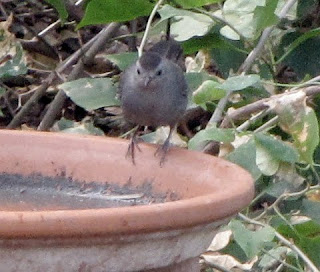 "We'd better get some sunflower seeds out. I'm expecting a Black-headed Grosbeak!" Brad laughed at me, but he put the sunflower seeds out anyway and filled the drippers and baths. A front had come in and the temperature had dropped to the 40's, so I bundled up in sweats and stepped out on the deck to watch the yard.
"We'd better get some sunflower seeds out. I'm expecting a Black-headed Grosbeak!" Brad laughed at me, but he put the sunflower seeds out anyway and filled the drippers and baths. A front had come in and the temperature had dropped to the 40's, so I bundled up in sweats and stepped out on the deck to watch the yard.There were absolutely no birds. Feeders were full; drippers were dripping. But all was silent except for the wind.
I went back in the house, down the stairs, and opened the garage door. I knew what I'd find out in the yard. Sure enough--a Cooper's Hawk flew from the Oak tree!
(This photo is not of the hawk I saw yesterday.
 It's of a Cooper's we had on the boat lift a few weeks ago.)
It's of a Cooper's we had on the boat lift a few weeks ago.)At this time of year a quiet yard, if the feeders are full, often signals the presence of a Cooper's or Sharp-shinned Hawk, two birds that hang out around feeders and cause other birds to scatter. I've seen them pluck a Red-winged Blackbird out of the air near a feeder. (I said "them" in the previous sentence because I'm not sure which of the two species I was watching that day. They are hard to distinguish since a large Sharpie [female hawks are the larger ones] can sometimes be almost as big as a small male Cooper's.) I'm pretty sure the one I saw yesterday was a Cooper's Hawk. As it flew out of the tree and into a yard down the road, it looked very large to me.
Now, back to the main story. Remember what I told you I said as I got out of bed yesterday morning? I just had a feeling about that Black-headed Grosbeak. It is rare in this area but shows up every year somewhere in the Rio Grande Valley. At this time last year we had a gorgeous adult male in the yard. It was black and orange with a surprising narrow band of creamy lemony coloring on its breast that sort of blended the orange into the white lower part of its belly. I really wanted to see another in the yard now that I have a camera with a zoom.
And, no sooner said than done .... when the birds came out of hiding, there on the driveway eating seed among the blackbirds and doves and sparrows was a Black-headed Grosbeak! It had the more subdued coloring of a first winter male, rather than the vivid colors of last year's adult bird, but still it was a welcome sight.
 When I called Brad out to the deck to point out our visitor, he asked me what else I'd like to see in the yard. I thought for a moment and said, "A catbird--we haven't seen one yet this winter."
When I called Brad out to the deck to point out our visitor, he asked me what else I'd like to see in the yard. I thought for a moment and said, "A catbird--we haven't seen one yet this winter."Are you ahead of me? You're right--a Gray Catbird with its perky little blackish cap was perched on the edge of one of the bathing saucers.
 Just ask for what you want. If you build it (or fill up your feeders and baths), they will come!
Just ask for what you want. If you build it (or fill up your feeders and baths), they will come!



















 I think maybe it is excited about the other kiskadee and not the berries. (My photos are not the best, but you get the idea.) The way the bird thrust up its usually hidden gold crest was really cool. Almost everything about Kiskadees is cool: I love the big football-shaped nest they made in the anacua tree last summer and the way they say "Oh boy!" and the way they stand up to the bully mockingbirds and gobble up the berries and the way they swoop down and then up when they cross the driveway from one bath to the other.
I think maybe it is excited about the other kiskadee and not the berries. (My photos are not the best, but you get the idea.) The way the bird thrust up its usually hidden gold crest was really cool. Almost everything about Kiskadees is cool: I love the big football-shaped nest they made in the anacua tree last summer and the way they say "Oh boy!" and the way they stand up to the bully mockingbirds and gobble up the berries and the way they swoop down and then up when they cross the driveway from one bath to the other.